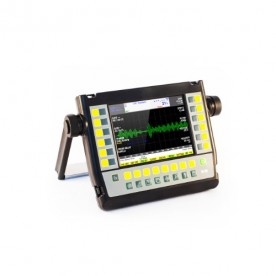- Home
- About Us
- Products
- Rohmann Eddy Current
- Secu-Chek UV-LED Lamps
- Sonatest
- MR Chemie
- NOVO DR
- Hoffmann Tam Panels
- Desoutter Industrial Tools
- Novotest
- Integrated Design Tools (IDT Vision)
- Dakota NDT
- DeFelsko Corporation
- AVIONICS
- Sonotec Ultrasonic Solutions
- Sonotec Ultrasonic Hand-Tools
- G.A.L. Gage Company
- Western Instruments Inc.
- Esders Gas Technology
- Yoancomposite
- Hinode Electric
- Services
- News
- Contact Us
 (65) 6878 0608  (65) 6878 0609 |

Overview
The DIO1000 SFE ultrasonic tester represents the pinnacle of innovation in industrial test instrumentation, combining extensive instrument manufacturing experience with a new generation of electronic components. This revolutionary instrument offers the best features and performance available for industrial testing.
The DIO1000 SFE ultrasonic analyzer represents the perfect balance between functionality and ergonomics, making it the ideal instrument for use in laboratories, field situations, and any environment where reliable and accurate inspections are required. Thanks to its advanced design and cutting-edge technology, this instrument offers a full range of features to meet the most demanding industrial needs.
MAIN FEATURES
-
Well balanced between ergonomics and functionality: easy solutions for daily applications in workshop, laboratory, and outdoors.
-
Adjustable handle keeps instrument stable on any surface, even round parts.
-
Large bright color LCD screen (1024 × 768 pixels) with excellent visibility in direct sunlight.
-
Optimum performance and extended connectivity.
-
Lightweight: 1.28 kg / 3.04 lbs and just 34 mm thin.
-
Combines digital design advantages with detailed dynamic echo information to bring back the “analog look and performance,” using a 200 MHz sampling rate.
-
Direct access to 12 functions.
-
Burst pulser: selectable and tunable for optimum probe matching to handle a wide range of tough-to-penetrate applications.
-
EMAT capability for non-contact testing.
-
Trigonometric flaw location function with curvature correction:
-
Automatically calculates depth, surface distance, and sound path to flaw along the inspection leg when using angle beam probes.
-
Time-of-Flight (TOF) measurements displayed in mm, inches, or µm.
-
-
Standards and tools supported: DAC, JIS-DAC, AVG, API, Automatic Thicknessmeter, Auto Gain, Auto Freeze.
-
Weld rating calculation: simplifies rating of indications in welds according to AWS Specification D1.1.
-
B-scan imaging: thickness mode or RGB palette.
APPLICATIONS:
-
Aerospace – composite testing
-
Steel production – large castings, hot and cold rolled steel
-
Engineering – welds and joints
-
Railway – track junctions in manganese steel
-
Energy – austenitic welds, drive shafts etc.
-
Automotive – spot weld testing
-
Customized applications
Specifications
| Display: | Color TFT sunlight, 1024 pixels (W) X 768 pixels (H) |
| Display Update Rate: | Minimum 60 Hz |
| Display dimensions: | 99×130 mm |
| True Sampling Rate: | 200 MHz, 12-bit |
| Operating Temperature: | -10 °C to 60 °C -40 °C to 70 °C |
| Storage Temperature: | -40 °C to 70 °C |
| Power Requirements: | AC Mains: 100-120 V AC, 200-240 V AC, 50-60 Hz |
| Battery: | Built-in and external rechargeable Li-Ion battery pack rated at 3.6 V at 16 Ah 10 hours, depending on display brightness |
| Battery Operating Time: | 10 hours, depending on display brightness |
| Keypad: | Graphic symbols, International |
| Languages: | Selectable in menu, user-defined custom language |
| Memory: | 2–16 GB |
| Dimensions: | 224×188×34 mm |
| Weight: | 0.74 Kg without battery + 0.54 kg battery for 10 working hours |
| PC Requirements: | PC running minimum Microsoft Windows Vista®, Microsoft Windows XP®, Microsoft Windows 2000®, |
| Warranty: | Two years warranty, battery not included. Optional three year warranty available |
Inputs / Outputs
| Transducer Cable Connectors: | Lemo® |
| Communications Ports: | USB, RS232, Ethernet, Wireless Ethernet (optional), Bluetooth (optional) |
| B-scan input: | Encoder, A, B – pulses, start, TTL 5 V, Encoder supply – switchable 5V |
| High Speed Parallel and TTL Port: | Alarm outputs, trigger in/out control |
| Analog Output: | Selectable voltage output of depth or amplitude data |
Pulser
| Peak Memory: | Pulse repetition rate up to 20 kHz and peak envelope of A-Scan display |
| Pulser Type: | User Selectable: Tunable square wave, negative spike excitation, burst |
| Pulser Energy: | Low (100 V) and Max (400 V) |
| Damping: | 50, 57, 200, and 1000 Ohms |
Calibration
| Auto Transducer Calibration: | Automated calibration of transducer, zero offset and/or velocity |
| Units: | Metric or microseconds |
| Material Velocity: | From 100 to 15240 m/s in steel |
| Range: | Standard 1 mm to 60,000 mm in steel |
| Refracted Angle: | Fixed settings of 0°, 30°, 45°, 60°, 70°, or variable from 10° to 90° in 0.1° steps for calculations |
| Test Modes: | Pulse Echo, Dual, or Through Transmission |
Gates
| Gate Monitors: | Four independent flaw gates controllable over entire sweep range – Floating gate, Interface gate, Measuring gate (relative, absolute, amplitude, time), Back-wall echo attenuator |
| Alarms: | Selectable threshold positive/negative or minimum depth modes |
Measurements
| A-scan memory: | 40 000 A-scans (up to 200 000 optional) – printscreen PNG, A-scan, setup |
| B-scan memory: | 10 km of B-scan, 1 mm resolution |
| Peak Hold: | Freezes Peak Memory echo envelope for recorded waveform comparison with live A-Scan |
| Auto Gate: | Thickness |
| DAC: | Standard, up to 20 points, 111 dB dynamic range (71dB continual) |
| TCG: | For echo amplitude adjustment and evaluation |
| Spot weld: | Automatically Auto Gain echo, Auto Freeze |



